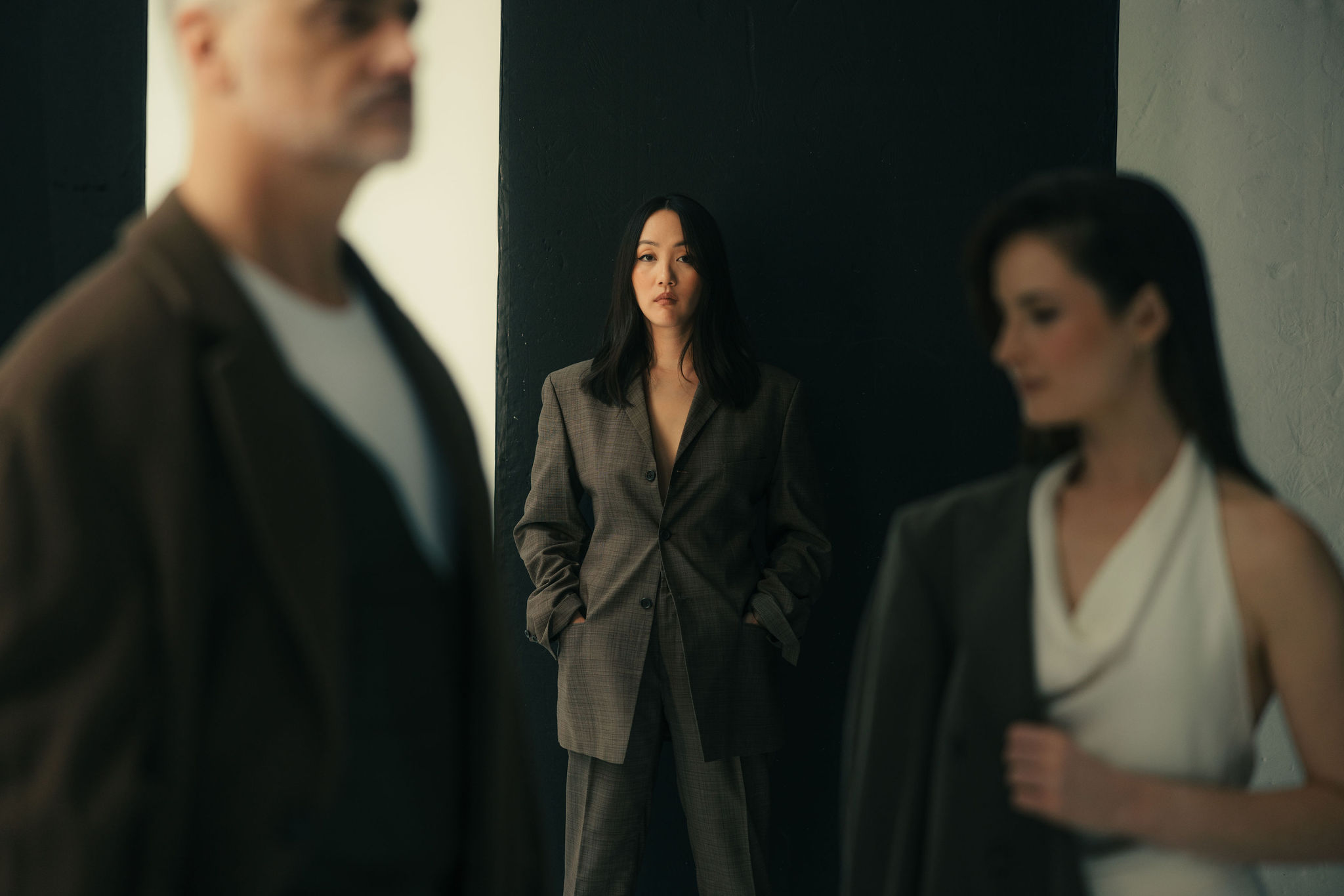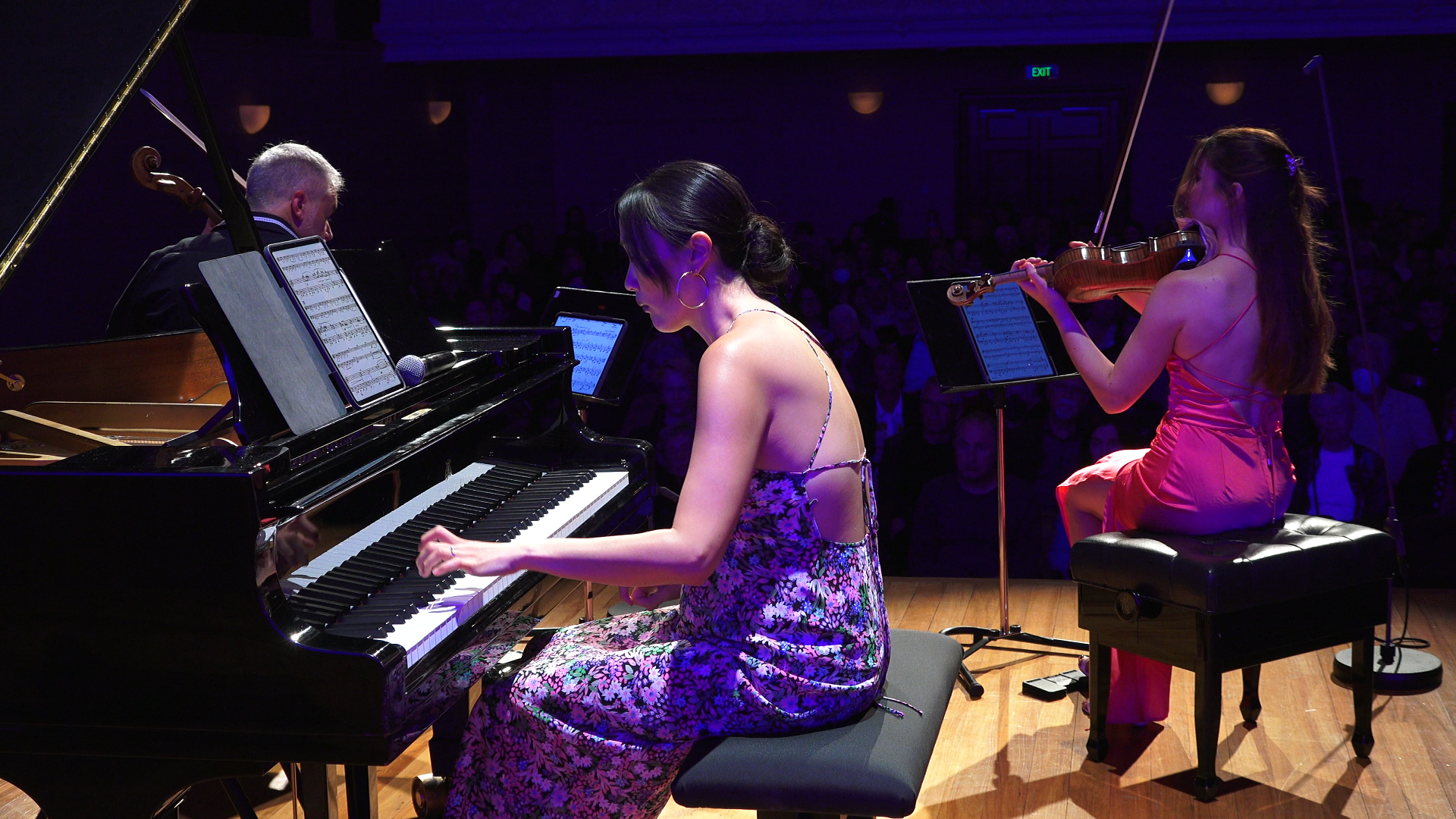Loft Series 2: Braid
25sep7:00 pmLoft Series 2: BraidAuckland Tuesday performance
Event Details
Braid CLEMENT • MENDELSSOHN • KATS-CHERNIN • KELLY • SCHUMANN Ashley Brown (cello) with guest musicians Benjamin Baker (violin) and Stephen De Pledge (piano) In recognition of the 125th anniversary celebration for women’s
Event Details
Braid
CLEMENT • MENDELSSOHN • KATS-CHERNIN • KELLY • SCHUMANN
Ashley Brown (cello) with guest musicians Benjamin Baker (violin) and Stephen De Pledge (piano)
In recognition of the 125th anniversary celebration for women’s suffrage in New Zealand, Braid unleashes an all-female cast of composers. These remarkable women are represented in this powerful tribute by a perfect tangle of traits – enigma in the Clement (NZ), protective embrace in the Kelly (NZ), enduring strength in the Kats-Chernin (AUS), compassion in the Schumann (GER) and emotional wisdom in the Mendelssohn (GER).
Programme:
Rachel Clement (NZ): Shifting States – Sabbia (Sand)
Fanny Mendelssohn (GER): Piano Trio in D Minor
Elena Kats-Chernin (AUS): Spirit and the Maiden
~
Victoria Kelly (NZ): Sono
Clara Schumann (GER): Piano Trio in G Minor
TICKETS: $50 Adults / $25 Students
Time
September 25, 2018 7:00 pm(GMT+00:00)
Programme Notes
Rachel Clement (NZ; b. 1972): Shifting States
1. sabbia (sand)
Rachel Clement studied composition with John Rimmer and John Elmsly at the University of Auckland, graduating with a Bachelor of Music (Hons.) in 1995 and a Master of Music (composition) with distinction in 1997. She has composed for a range of contemporary performers and groups, including 175 East and Stroma, lectured part-time in Composition at the University of Canterbury, managed the library of the Christchurch Symphony, and worked as the National Secondary Schools Arts Co-ordinator for Music (on behalf of the Music Educators of NZ, Aotearoa) under contract to the Ministry of Education. In 2005 and 2006 she held the position of Mozart Fellow at the University of Otago.
Sabbia (sand) is from a set of five short pieces inspired by an interest in mid-Twentieth Century art glass. Clement explores the process of changing state, or changing phase (freezing, melting, vaporization, condensation and sublimation) essential to the production of the many types of art glass. Each piece expresses a style of finished effect (e.g. bubbles, flowers, submerged colour) with sand being the first step, and most essential ingredient.
Shifting states was commissioned by NZTrio with funding from Creative New Zealand.
Fanny Mendelssohn (GER; 1805 – 1847): Piano Trio in D Minor, Op.11
i. Allegro molto vivace
ii. Andante espressivo
iii. Lied (Allegretto)
iv. Allegro moderato
“Music will perhaps become Felix’s profession, while for youit can and must be only an ornament” (Abraham Mendelssohn, father, 1820)
In the mid 1980s, in Berlin, a researcher by the name of Marcia Citron finally gained access to the papers of Fanny Mendelssohn. She had to get past the curator, a fervent admirer of Felix, who called his older sister “just a housewife” and had blocked access to the archives for his entire tenure. She wore him down eventually. And what she found was astonishing – letters and diaries, all written in anOld German that she had to enlist the help of her landlady to decode, some 500 compositions that included a Cholera Cantata, dozens of songs and piano Songs Without Words, and her own wedding music (written while the rest of the family were celebrating the night before). Like Felix she turned out to have been a formidable pianist, so much so (“she plays like a man”) that even the best musicians were terrified of playing for her: like Felix she had been composing since the age of ten; like Felix she was also a fine conductor; and it was not unusual for visitors, apparently, to find her actually the more talented of the pair. Felix saw this very well – they discussed all of their music together, they were inseparable – and he published many of her songs under his own name. Indeed, when he was invited to Buckingham Palace and Queen Victoria announced that she would sing, he had the embarrassment of having to confess that this favourite song of Her Majesty’s was actually by his sister, and not his own.
And yet, Felix was sent off on a Grand Tour of the capitals of Europe to gain musical experience, and Fanny stayed at home to prepare her trousseau. Her husband (Wilhelm Hensel, the court painter) was supportive, luckily, and actually refused to marry her unless she promised to continue to compose: she did, but she never published much, or imagined anything but a private audience at home. This is her last published opus, written for her sister’s birthday on April 11, only a month before her death.
The first movement was called a masterpiece even at the time, with rumbling piano ushering in her gorgeous gift for melody. Two song-like movements follow – she quotes an aria from Felix’s Elijahin the third – and the finale, opening with a stately Bach-like flourish, quickly turns passionately romantic before wrapping up the whole with perfection.
Programme note by Charlotte Wilson
Elena Kats-Chernin (AUS; b. 1957): Spirit and the Maiden
Born in 1957 in Uzbekistan, Elena Kats-Chernin received training at the Gnessin Musical College before immigrating to Australia in 1975. She graduated from the New South Wales Conservatorium of Music in 1980 and was awarded a DAAD (German academic exchange) grant to study with Helmut Lachenmann in Hanover. She remained in Germany for 13 years, returning in 1994 to Australia where she now lives in Sydney.
Elena has created works in nearly every genre. Among her many commissions are pieces for Ensemble Modern, Australian Chamber Orchestra, Australian World Orchestra, the Adelaide, Tasmanian, Melbourne and Sydney Symphony Orchestras, the Australian Brandenburg Orchestra, City of London Sinfonia, Swedish Chamber Orchestra and the North Carolina Symphony. In 2000 she collaborated with leading Australian choreographer Meryl Tankard on Deep Sea Dreaming which was broadcast to an audience of millions worldwide as part of the opening ceremonies of the Sydney 2000 Olympic Games.
Elena’s music continues to be heard on TV and at the cinema in the UK with the long-running Lloyds TSB advertising campaign ‘For the journey…’, Meryl Tankard’s Wild Swans, and the theme in claymation film Max & Mary by Adam Elliott. She is one of the subjects of a Creative Minds 6-episode series of artist portraits by Robin Hughes. In 2017 she was composer in residence with the Melbourne Symphony Orchestra. Her music is published exclusively by Boosey & Hawkes.
A work of 3 movements, Spirit and the Maiden is based on a Russian fairy-tale about a young girl whose job it was to carry water back and forth between her village and the well. One summer’s afternoon, as she put down her buckets and rested for a moment on the wall of the well, her turquoise shawl, a gift from her grandmother, rumoured to be a witch, slid from her shoulders and sank into the dark cold waters. When she reached down to grasp it, to her surprise what she felt was not her shawl but a hand.
As she pulled it out, she gasped at the sight of a beautiful young man emerging from the water – the water spirit. She was transfixed with wonder at his pale beauty, his voice deep like a resounding waterfall, and her heart beat so loudly, she thought her chest would burst.
The second movement describes a momentary love affair, dancing, teasing, and twirling in the sunlight which glistened on his steaming skin, his hands running through her hair making it wet and curly as she flirted with him. But soon he began to evaporate in the noon-day sun, until suddenly he was a mere pearlescent drop left on her palm.
The third movement laments as she cautiously placed him back in the water, the heaviness dragging her down into the depths. As she floats down into his embrace, blissfully falling to the deepest place, her lips turn blue and she drowns in his arms. When he realises what he’s done, his grief is so great, he wraps her in the turquoise shawl and swims back to the light, laying her body on the surface and, summoning all his magic, changes her into a water lilac where she has bloomed ever since.
Victoria Kelly (NZ; b. 1973): Sono
Victoria is a composer, performer, producer and director of music. Having focused on music for the screen for most of her 30-year long career, she now concentrates on contemporary classical music, as well as creative projects with a small group of artists, including a longstanding collaboration with Neil Finn. She is currently the Director of NZ Member Services at APRA AMCOS.
Victoria has enjoyed a hugely diverse career, working with musicians and artists across the worlds of cinema, dance, theatre, popular and classical music. She’s worked with the New Zealand Symphony Orchestra, the Auckland Philharmonia, the New Zealand String Quartet, NZTrio, Stroma, Michael Houstoun, Stephen De Pledge, Neil & Liam Finn, Don McGlashan, Anika Moa, SJD, Shapeshifter, Okareka Dance Company, Jonathan King, Robert Sarkies, Fran Walsh and Sir Peter Jackson, among many others. In 2011 she was the Music Director and principal composer for the Opening Ceremony of the Rugby World Cup at Eden Park.
“The idea for this piece began with the Portuguese word ‘sono’ which describes the desire to sleep in order to rejoin a dream. In my experience, it’s impossible to do this once you have woken.
The trio begins with an impassioned event which soon disappears, leaving the piano alone to dream about it. A repeating piano note emerges and remains, representing the real world lingering in the background. Around this note, the dreams wander in chords and gestures, deep breaths and ascending melodies.”
Sono was commissioned by the Turnovsky Trio in 1999.
Clara Schumann (GER; 1819 – 1896):Piano Trio in G Minor, Op.17
i. Allegro moderato
ii. Scherzo and Trio
iii. Andante
iv. Allegretto
“Composing gives me great pleasure… there is nothing that surpasses the joy of creation, if only because through it one wins hours of self-forgetfulness, when one lives in a world of sound.”
Clara Schumann was one of the great forces of nature. The most famous pianist in Europe, far more famous than her composer husband, she had been touring the great capital cities since the age of 11 and was received with a sort of mania wherever she went – besought by Chopin and Liszt and Paganini, gifted jewels and fifty gold ducats by the Empress for her Beethoven recitals in Vienna, awarded Austria’s highest musical honour despite being only 18, and a foreigner, and female – all without precedent. The Emperor himself had to make an exception.
She was already engaged to Robert, by that stage, having met him at the age of only 8 – at one of her concerts, of course – and they had begun the arduous process of defying her manager-father’s wishes in order to get married, which they finally accomplished one day before she came of age. Not that she scaled back her career: she always remained the breadwinner for the family, continuing to tour and to teach. She acted as concert agent for herself and for Robert: she single-handedly invented the concept of the modern concert pianist, being the first to perform from memory, and her expressive new style influenced schools as far as Britain and the States; she shaped the tastes of a generation with her preferences, making the careers of Robert Schumann and Johannes Brahms: she managed Robert’s terrible illnesses, and his musical legacy after he died; and all this time she shepherded a family of seven children (surviving children, she was almost always pregnant). Even that she excelled at. She later took on her grandchildren when her son died and famously, when the children were trapped in the centre of Dresden during the Dresden Uprising of 1849, she calmly walked into the city through the gunfire, straight through the front lines, defied a pack of armed men who confronted her, fetched her children, and walked hand-in-hand straight back out again.
And not only that, she composed. Her works – 23 published opuses, which is only half of her output – include songs, pieces for piano and violin, vocal pieces, and a piano concerto which she performed at the Leipzig Gewandhaus, Mendelssohn conducting, at the age of only 14. She never had time to write more, as it might well be imagined; her works suddenly tail off when Robert tried to kill himself and shortly after was committed to the asylum, when she was 36. But at least we have this, her only piano trio, composed when she was 27. It’s a masterpiece by any standards.
A lyrical, passionate, perfectly structured first movement leads into a gutsy, individual, humorous scherzo and trio. The andante is full of a heartfelt love and the allegretto, quickly becoming intensely dramatic, leads to a perfectly paced and confident finale. Many think she was actually a better more natural composer than her husband. If only she’d had more time.
Programme note by Charlotte Wilson


